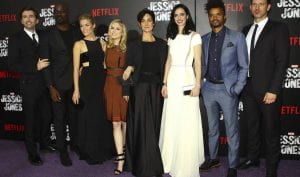Looks like indentations aren’t working! Oh well…
Source 1 (Peer Reviewed):
Atkin, David J., Jay Moorman, and Carolyn A. Lin. “Ready for Prime Time: Network Series Devoted to Working Women in the 1980s.” Sex Roles, vol. 25, no.11-12, 1991, pp. 677-684. Springer Open Choice, https://link.springer.com/content/pdf/10.1007%2FBF00289571.pdf
This research paper contains the findings of an analysis of shows from the 1980s, a period recognized for a large increase in the depiction of the “working woman.” The study focuses solely on shows where the lead is an employed woman, including “Roseanne,” and “Murphy Brown.” The study reveals certain interesting findings, such as that most employed women characters were also not depicted as married, or that most working women were still under the direct authority of a male executive. The ending analysis also attributes this boost in working women, not to the progressiveness of the networks, but rather the need for networks to compete with one another after the initial success of certain women-centered shows from the late 1970s. In our research, the data we collect should reflect this boost in employed women characters. Thus, this source is valuable because it provides an explanation for this influx, and we will be able to see if this trend persisted to the same degree in later decades.
Source 2:
Dixon-Smith, Matilda. “Why It’s Still Revolutionary To Watch Women Work On TV.” Junkee, 29 July 2017, http://junkee.com/tv-women-working-shows/114239.
This article by Junkee Media elaborates on the current working women of today’s television. It also describes some of the female characters and shows that are regarded as milestones in the pure representation of “the career woman,” which broke the previous mold of women being caretakers or constantly pursuing love interests. The piece also discusses setbacks in this progress of representation, which surprisingly includes shows with a majority female cast. Lastly, the article discusses the importance of proper representation of “the career woman” on television, as it influences how real working women are perceived and acted upon by society. This paper will be valuable to our research because it justifies the importance of our topic and why our research is necessary for discussion. It will also be interesting to see if the shows that are considered milestones for representation appear in our list of popular shows to analyze. This will indicate if they were widely accepted by society or not.
Source 3 (Peer Reviewed):
Dozier, David, Nora Horan, and Martha M. Lauzen. “Constructing Gender Stereotypes Through Social Roles in Prime-Time Television” Journal of Broadcasting and Electronic Media, vol. 52, no. 2, 2008, pp. 200-212. Taylor & Francis Online, https://www.tandfonline.com/doi/full/10.1080/08838150801991971, doi:https://doi.org/10.1080/08838150801991971.
This paper analyzes the varying nature of roles of characters of popular recent primetime television shows between 2005 and 2006. In particular, the research seeks to determine the relationship between gender and the type of role played: “interpersonal” or “work-related.” The study found that interpersonal roles (those involving relationships or care) were typically played by men, while work roles are dominated by men, thus perpetuating the long-standing stereotype set by past years. However, the study also found that shows with more women writers reduce the gap by having a more equal proportion of men and women playing interpersonal roles. In contrast, shows with all men writers feature a more equal proportion of men and women playing work roles. This study will be important to understand influences on the data we collect related to women employment, as this study shows that the presence of employed women characters can be affected by the number of male writers for the show.
Source 4:
Lauzen, Martha M. “Boxed In 2017-18: Women On Screen and Behind the Scenes in Television.” San Diego State University, Sep 2018, https://womenintvfilm.sdsu.edu/wp-content/uploads/2018/09/2017-18_Boxed_In_Report.pdf.
This research paper from San Diego State University is a large list of findings that resulted from an analysis of over two decades worth of prime-time television. The paper covers nearly every aspect of women’s representation in television, ranging from employment in the show’s production to on-screen appearances. The paper even distinguishes findings between various sources of television, such as broadcast TV, cable, and streaming. The paper is valuable because it presents information in a very easy to read format, making it easy to see how women’s representation in television has changed. The findings also contain highly relevant findings regarding the presence of employed women in television in comparison to men. Though the paper does not get too specific, it provides a good general indication of the current presence of employed women versus their male counterparts. The most promising aspect of this paper is that it is a very recent source, published in September 2018. This means that the data contained is the most accurate out of all the sources thus far.
Source 5 (Peer Reviewed):
Olson, Beth, and William Douglas. “The Family on Television: Evaluation of Gender Roles in Situation Comedy.” Sex Roles, vol. 36, no. 5, 1997, pp. 409-427. ProQuest, http://prx.library.gatech.edu/login?url=https://search.proquest.com/docview/225376065?accountid=11107.
This research paper is a statistical analysis of the themes that appeared in popular family-centric television, and the character tropes that appeared along with those themes. The paper also changes how these themes and character tropes evolved over time (starting from the debut of popular television in the 1950s), explaining the introduction of some new ideas and the descent of once popular themes. This source is valuable to our research because it is the only one to focus solely on family shows. This is critical, given that women characters have often been depicted in the context of being a family caregiver over being employed. The research also assesses the degree to which audiences considered the female character to be equivalent in terms of gender roles. The study found that newer (note that shows considered “newer” were aired in the early 1990s) demonstrated higher levels of equality. This could be another interesting parameter to measure in our research.
Source 6 (Peer Reviewed):
Stout, Jane G., Victoria A. Grunberg, and Tiffany A. Ito. “Gender Roles and Stereotypes about Science Careers Help Explain Women and Men’s Science Pursuits.” Sex Roles, vol. 75, no. 9-10, 2016, pp. 490-499. ProQuest, http://prx.library.gatech.edu/login?url=https://search.proquest.com/docview/1840619357?accountid=11107, doi:http://dx.doi.org/10.1007/s11199-016-0647-5.
This research study examines the relationship between the stereotypes associated with genders and STEM careers, and how they relate to real-world participation in STEM careers. Most of the research centers on the overwhelming majority of men with a formal STEM education in comparison to women, but it does indicate some increase in women participation in recent years. The study focuses mostly on genders but also factors in minority participation/stereotypes. The paper also addresses the source of the stereotypes that cause this real-life disparity, stating that a large contributing factor is the media’s depiction of people in STEM career fields. Therefore, this source will be useful in understanding the low percentage of female television characters with careers in STEM fields, which has almost always been depicted as being dominated by men. This also emphasizes an important aspect of our research topic: whether media influences reality, the opposite, or if there is a cyclical influence.

